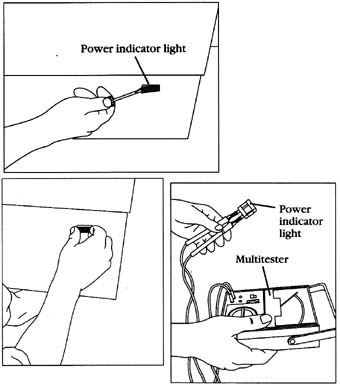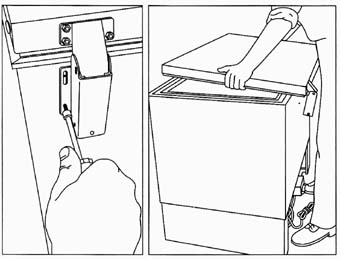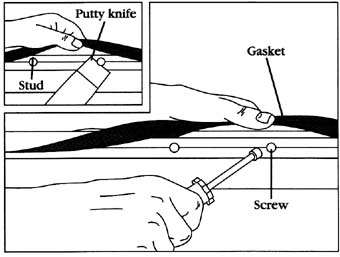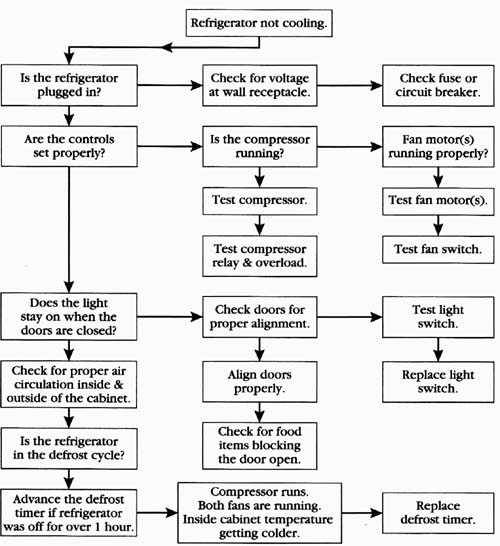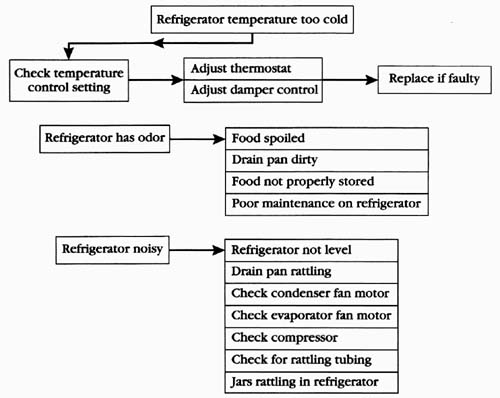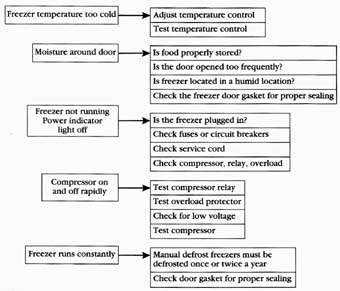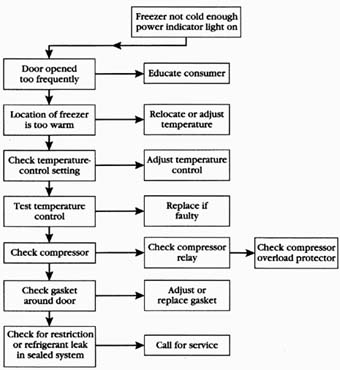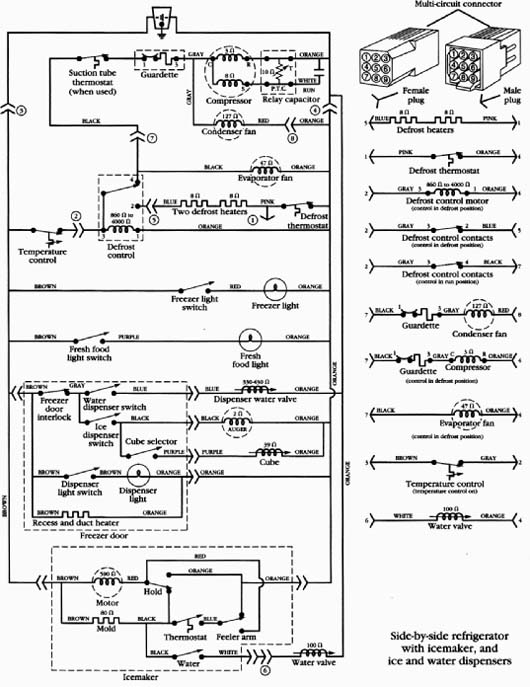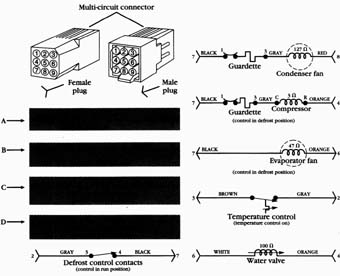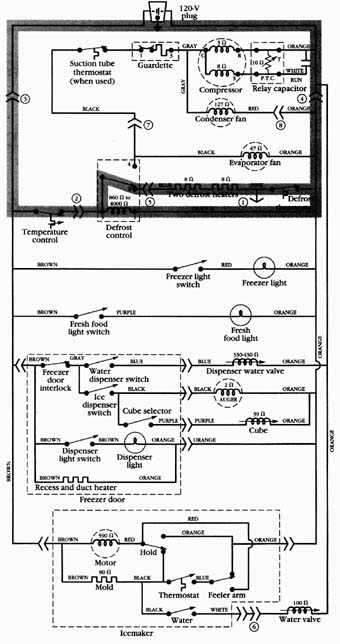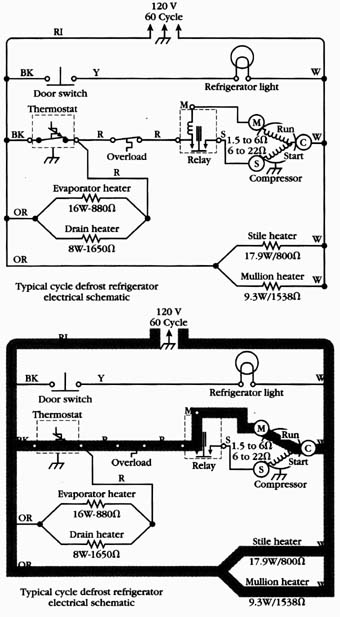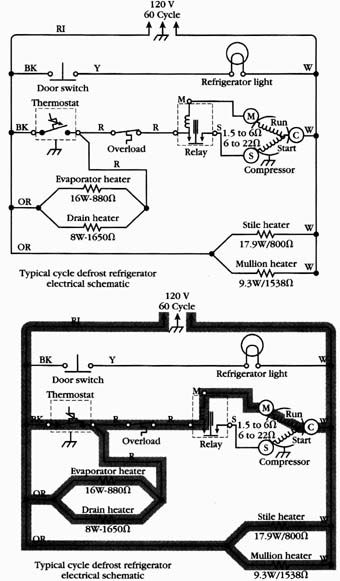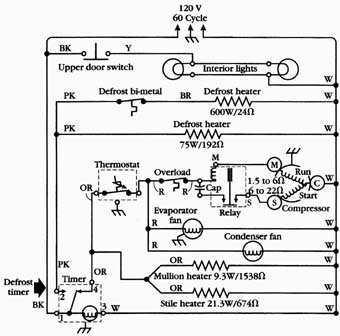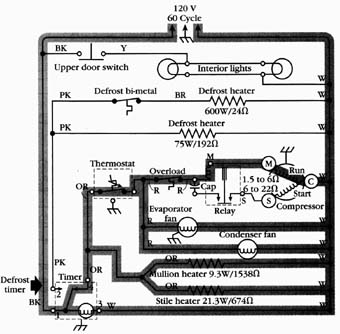Troubleshooting and Repairing--Refrigerators and freezers (part 2)
| HOME | Troubleshooting | DIY Tips |
|
REPAIR PROCEDURES Each repair procedure is a complete inspection and repair process for a single refrigerator/freezer component. It contains the information you need to test and re place components. Door gasket: The typical complaints associated with door gasket failure are: 1. Sweating inside the cabinet. 2. Temperatures inside the cabinet are warmer than normal. 3. Ice forming on the freezer walls. 4. Door gaskets not maintained properly. 1. Verify the complaint--Verify the complaint by checking the door gasket for proper sealing and alignment. Inspect the gaskets for any damage. 2. Check for external factors-- You must check for external factors not associated with the appliance. Is the appliance installed properly? Were the doors reinstalled correctly? 3. Disconnect the electricity--Before working on the refrigerator/freezer, disconnect the electricity. This can be done by pulling the plug from the receptacle. Or disconnect the electricity at the fuse panel or at the Circuit breaker panel. Turn off the electricity. 4. Gain access to the door gaskets--To access the door gaskets, open the refrigerator/freezer door. The gaskets are located on the door. 5. Test the door gaskets--To test the gaskets for proper sealing, take a dollar bill and place it between the gasket and the flange of the outer cabinet ( Figr. --4). Pull on the dollar bill. When pulling on the dollar bill, you should feel some tension as it grips the bill. This means that the gasket is making good contact with the refrigerator/freezer flange. Repeat this test in other areas where you suspect problems with the gasket. If the gasket fails this test, then the next step is replace the gasket. For the doors to close and seal properly, the refrigerator should tilt backwards of an inch. This is accomplished by raising the front legs, or wheels, according to the installation instructions. If you are still unable to get the doors to close properly, then check the doors for sagging or warping ( Figr. --5). Also, check the floor to see if it’s level under the refrigerator/freezer. Check from front to back, and from side to side. 6. Remove the door gasket--Before you get started, remove all of the food from the door. To remove the door gasket, pull back on the gasket, which exposes the retaining strip and screws. Loosen the screws about half way, but don’t remove them ( Figr. --6). Gently remove the gasket from around the door ( Figr. --71). __6 Peel back the gasket to gain access to the retaining strip and screws. __5 Warped or sagging doors must be corrected so that the refrigerator/freezer will operate properly. --- Refrigerators and freezers
Cabinet; Door; Magnetic gasket 7. Install a new door ,gasket Before installing the new gasket, soak it in warm water. This will make the gasket soft and easier to install. Starting at either top corner, insert the flange of the gasket behind the retaining strip and/or door liner. Proceed all the way around the door. When the gasket is in place, begin to tighten the screws slightly all around the door. Now close the door, the gasket should make contact with the cabinet flange; evenly, and all around the door ( Figr. --8). The door gasket might be adjusted by aligning the door panel, as in Figr. --9. To align the door, twist the door in the opposite direction of the warp. Close the door, and check for the gasket sealing against the cabinet. Now that the door gasket is sealing properly, tighten the screws completely. If the gasket is distorted or if it has wrinkles in it, use a hair dryer to heat the gasket and mold it to its original form. Then, recheck to be sure the gasket seats against the flange properly. Next, check the gap between the door and the cabinet ( Figr. --9) on the hinge side. Use a penny which is about A of an inch in diameter to check the gap. Slide the penny from the top hinge to the bottom hinge. The door might be adjusted by moving the top hinge and by adding or removing shims to the center and bottom hinges. Be sure that the doors line up evenly with the sides of the cabinet and evenly with each other. Also, check that when both doors are opened simultaneously (top mount refrigerators only), that they don’t hit against each other. Thermostat (cold control): The typical complaints associated with thermostat (cold control) failure are: 1. The refrigerator/freezer is not cold enough. 2. The refrigerator/freezer is too cold. 3. The refrigerator/freezer runs all the time. 4. The refrigerator/freezer doesn’t run at all. 1. Verify the complaint--Verify the complaint by checking the control setting. Turn the control off; then turn it on again, to see if the refrigerator/freezer starts. 2. Check for external factors-- You must check for external factors not associated with the appliance. Is the appliance installed properly? Explain to the user how to set the controls. 3. Disconnect the electricity--Before working on the refrigerator/freezer, disconnect the electricity to the refrigerator/freezer. This can be done by pulling the plug from the receptacle. Or disconnect the electricity at the fuse panel or at the circuit breaker panel. Turn off the electricity. --- Refrigerators and freezers: 4. Gain access to the thermostat--To access the thermostat, open the fresh food door. Look for the control dial that has the word “off” printed on it. This is the control that turns the compressor on and off. Remove the dial ( Figr. --10). Next, remove the two screws that secure the control ( Figr. --11). Remove the wires from the terminals. On some models, the capillary tube is inserted in the air duct; but on other models, the capillary tube might be attached to the evaporator coil. At this point, if the capillary tube is attached to the coil, don’t remove the capillary tube yet. Test the control first. __11 Be sure that the electric is disconnected before attempting to remove the thermostat. Note how the capillary tube is routed, and if it’s secured to anything. Also, note in which direction the terminal end of the thermostat is pointed, when removing the thermostat. If by error you install the thermostat upside down, the dial indicators will be incorrect. The thermostat inside the cabinet could be set on the wrong position. 5. Test the thermostat--To test the thermostat, place the ohmmeter probes on the terminals ( Figr. --12). Set the range scale on R x 1, and test it for continuity. With the control set in the off position, you should not read continuity. When the control is set to the highest position, you should read continuity. If the thermostat is good, the problem must be elsewhere.
6. Remove the thermostat--With the thermostat control housing already removed, the capillary tube must now be removed. Because there are many different models on the market today, Figr. --13 represents only a few types. The capillary tube might be routed through the control housing ( Figr. --13A). The capillary tube might be secured to the evaporator by means of a clamp ( Figr. --13B). The capillary tube might be inserted into a housing that senses how cold the air is ( Figr. --13C). Whichever way the capillary tube is installed, remove it carefully so as not to damage the other components. 7. Install a new thermostat. To install the new thermostat just reverse the order of disassembly, and reassemble. Then, test the control. Just remember to reinstall the capillary tube in the same location from where it was removed. If you do not, the refrigerator/freezer won’t work properly. Defrost timer: The purpose of the defrost timer is to regulate the frequency of the defrost cycles, and the duration of each cycle. The typical complaints associated with defrost timer failure are: 1. The refrigerator/freezer does not defrost. 2. The storage temperature in the cabinet is too warm. 3. The compressor won’t run. 1. Verify the complaint. Verify the complaint by asking the customer to describe what the refrigerator/freezer is doing or did. 2. Check for external factors-- You must check for external factors not associated with the appliance. Is the appliance installed properly? Are the doors aligned properly? --- Refrigerators and freezers: 3. Disconnect the electricity. Before working on the refrigerator/freezer, disconnect the electricity to the refrigerator/freezer. This can be done by pulling the plug from the receptacle. Or disconnect the electricity at the fuse panel or at the circuit breaker panel. Turn off the electricity. 4. Gain access to the defrost timer. To access the defrost timer, you must first locate it. On some models, the defrost timer is located on the bottom, behind the toe plate; or it might be behind the temperature control housing, in the fresh food section ( Figr. --14); or it might be in the back of the refrigerator, behind the rear leg ( Figr. --15). 5. Remove defrost timer In order to test the defrost timer, it must be removed from its mounting position. Remove the two mounting screws from the defrost timer ( Figr. --15). Next, remove the wire harness plug from the defrost timer ( Figr. --16).
__15 Remember to always reconnect the green ground wire to the defrost timer and ground. --- Refrigerators and freezers: 6. Test the defrost timer. To test the defrost timer, place a screwdriver in the timer cam slot ( Figr. --17), and turn it clockwise until you hear the first “snap.” The defrost timer is now in the defrost cycle. At this point in time, you must read the wiring diagram to determine which numbered terminals are for the defrost circuit. For the purpose of demonstrating how to check for continuity of the switch contacts, Figr. --15A illustrates the internal components of this sample timer. Set the ohmmeter scale on R x 1, and place the probes on the terminals marked 2 and 3 ( Figr. --19). You should measure continuity. Next, rotate the timer cam until you hear the second “snap.” The meter will show no continuity, indicating that the defrost cycle is over and that the refrigeration cycle begins. Now, place the meter probes on the terminals marked 3 and 4. The ohmmeter will show continuity, indicating the refrigeration cycle is activated. Turn the timer cam once again, until you hear the first “snap.” The meter will show no continuity. At no time should there be continuity between terminals 2 and 4. (If so, the switch contacts are burned and welded together. The defrost timer must be replaced.) If the defrost timer passes this portion of the test, then you must determine if the timer mechanism is functioning. Place the ohmmeter probes on the timer motor leads and read the resistance. The resistance can be between 800 and 4000 ohms, depending on which type of timer is used by the manufacturer. If you are unable to read resistance, then the timer motor is defective.
Switch contacts Defrost #2 Common #3 Compressor #4 Ground #1
__19 Check switch contacts for continuity. If the defrost timer passes this portion of the test, then rotate the timer cam until you hear the first “snap.” Advance the timer cam again, counting the number of clicks until you hear the second “snap.” Write down the number of clicks on a piece of paper. Now rotate the timer cam again until the marks line up ( Figr. --18B), which indicates the beginning of the defrost cycle and the “snap” is heard. Advance the timer cam and count the clicks until there is one click left before the end of the defrost cycle. Take the timer and reconnect it to the wiring harness ( Figr. --16). Place the defrost timer on a nonmetallic surface. Motor drive gear --- Refrigerators and freezers: Be cautious when working with live wires. Avoid getting shocked. Reconnect the voltage supply to the refrigerator/freezer. Place the ammeter jaws around the wire attached to the number four terminal. The meter should indicate no amperage. Next, place the jaws on the number two terminal wire. The ammeter should indicate some amperage. Wait for approximately 10 to 15 minutes, you should hear a “snap” indicating that the timer has completed the defrost cycle. At this point, the ammeter will show no amperage on number two, but will indicate current flow at number four. If not, replace the timer. 7. Install a new defrost timer--To install the new defrost timer, just reverse the order of disassembly, and resemble. Remember to reconnect the ground wire to the defrost timer. Evaporator fan motor: The typical complaints associated with evaporator fan motor failure are: 1. The refrigerator/freezer temperature is warm. 2. The evaporator fan motor runs slower than normal. 3. The evaporator fan motor does not run at all. 4. The evaporator fan motor is noisy. 1. Verify the complaint Verify the complaint by asking the customer to describe what the refrigerator/freezer is doing, or did. Is the evaporator fan motor running? Is it noisy? 2. Check for external factors You must check for external factors not associated with the appliance. Is the appliance installed properly? Is there something hitting the fan blade? 3. Disconnect the electricity Before working on the refrigerator/freezer, disconnect the electricity. This can be done by pulling the plug from the receptacle. Or disconnect the electricity at the fuse panel or at the circuit breaker panel. Turn off the electricity. 4. Gain access to the evaporator fan motor To access the evaporator fan motor, the evaporator cover must be removed ( Figr. --20). Remove the screws that secure the cover in place. On some models, the evaporator fan assembly is located on the rear wall of the interior freezer compartment. 5. Test the evaporator fan motor The evaporator fan motor should be tested for proper resistance, as indicated on the wiring diagram. To test the evaporator fan motor, remove the wires from the motor terminals. Next, place the probes of the ohmmeter on the motor terminals ( Figr. --21). Set the scale on R x 1. The meter should show resistance. If no reading is indicated, replace the motor. If the fan blade does not spin freely, replace the motor.
6. Remove the evaporator fan motor To remove the evaporator fan motor you must first remove the fan blade. On most models, just pull the blade off the motor shaft. Be careful not to break the blade. On other models, the fan blade is held on the motor shaft with screws. Remove the screws. Then, remove the screws that secure the fan assembly to the cabinet ( Figr. --22). On some models, you must remove the fan shroud ( Figr. --23), by removing the shroud screws. 7. Install a new evaporator fan motor To install the new evaporator fan motor, just reverse the order of disassembly, and reassemble. When reinstalling the fan blades Onto the motor shaft, the fan blades should be positioned on the shaft so that one-third of its depth (approximately ‘/ protrudes through the fan orifice, in the direction of air flow. When re-installing any shrouds, grilles, ducts, or gaskets, always position them correctly to ensure the proper air flow through the evaporator, and within both compartments of the refrigerator/freezer. Remember to reconnect the ground wire to the motor. Reconnect the wires to the motor terminals, and test. Condenser fan motor: The typical complaints associated with condenser fan motor failure are: 1. The refrigerator/freezer temperature is warm. 2. The condenser fan motor runs slower than normal. 3. The condenser fan motor does not run at all. 4. The compressor is some times noisier than normal. 1. Verify the complaint Verify the complaint by asking the customer to describe what the refrigerator/freezer is doing. Is the condenser fan motor running? --- Refrigerators and freezers: Rear bracket 2. Check for external factors-- You must check for external factors not associated with the appliance. Is the appliance installed properly? Is there any foreign object blocking the condenser fan blade? 3. Disconnect the electricity Before working on the refrigerator/freezer, disconnect the electricity. This can be done by pulling the plug from the receptacle. Or disconnect the electricity at the fuse panel or at the circuit breaker panel. Turn off the electricity. 4. Gain access to the condenser fan motor Pull the refrigerator/freezer out and away from the wall. Remove the back panel, which is located at the bottom of the refrigerator/freezer. This will expose the compressor, the condenser fan assembly, and the condenser coil ( Figr. --24). Fan blade; Fan motor; Evaporator cover; Front bracket; Shroud screw
5. Test the condenser fan motor--A condenser fan motor should be tested for proper resistance, as indicated on the wiring diagram. Check the fan blade for obstructions. The blade should turn freely. Next, rotate the fan blade, and check for bad bearings. If you hear any unusual noises coming from the motor or if the fan blade is sluggish when spinning, replace the motor. To test the condenser fan motor, remove the wires from the motor terminals. Next, place the probes of the ohmmeter on the motor terminals ( Figr. --25). Set the scale on R x 1. The meter should show resistance. If no reading is indicated, replace the motor. 6. Remove the condenser fan motor--To remove the condenser fan motor, you must first remove the fan blades. Unscrew the nut that secures the blades to the motor. Remove the blades from the motor. Then, remove the motor assembly, by removing the mounting bracket screws ( Figr. --26). 7. Install a new condenser fan motor To install the new condenser fan motor, just reverse the order of disassembly, and reassemble. Remember to reconnect the ground wire to the motor. Reconnect the wires to the motor terminals and test. Defrost heater: The typical complaints associated with defrost heater failure are: 1. The refrigerator temperature is warm. 2. The freezer temperature is warm. 3. The refrigerator/freezer does not defrost. 4. Food loss. 5. No ice cubes. 1. Verify the complaint Verify the complaint by asking the customer to describe what the refrigerator/freezer is doing. Is there any food loss? Check the temperature in the compartments. Check for ice build-up on the evaporator cover. 2. Check for external factors You must check for external factors not associated with the appliance. Is the appliance installed properly? Compressor--Compressor terminals --- Refrigerators and freezers:
3. Disconnect the electricity Before working on the refrigerator/freezer, disconnect the electricity. This can be done by pulling the plug from the receptacle. Or disconnect the electricity at the fuse panel or at the circuit breaker panel. Turn off the electricity. 4. Gain access to the defrost heater To access the defrost heater, the evaporator cover must be removed ( Figr. --20). Remove the screws that secure the cover in place. 5. Test the defrost heater A defrost heater should be tested for proper resistance, as indicated on the wiring diagram. To test the defrost heater, remove the wires from the heater terminals. Next, place the probes of the ohmmeter on the heater terminals ( Figr. --27). Set the scale on R x 1. The meter should show resistance. If no reading is indicated, replace the defrost heater. 6. Remove the defrost heater To remove the defrost heater in this type of model, you must first remove the reflector shield ( Figr. --28). Bend the clip up and lift the shield. Do the same for the other end of the heater. Once the shield is removed, you can lift the defrost heater from its brackets. 7. Install a new defrost heater To install the new defrost heater ( Figr. --29), just reverse the order of disassembly, and reassemble. One important note to remember: on some models, don’t touch the glass because it will shorten the life of the heater. Remember to reconnect the wires to the heater. When reinstalling any shrouds, grilles, ducts, or gaskets, always position them correctly to ensure the proper air flow through the evaporator and within both compartments of the refrigerator/freezer. Defrost thermostat: The typical complaints associated with defrost thermostat failure are: 1. The refrigerator temperature is warm. 2. The freezer temperature is warm. 3. The refrigerator/freezer does not defrost. 4. Food loss. 5. No ice cubes. 1. Verify the complaint Verify the complaint by asking the customer to describe what the refrigerator/freezer is doing. Is there any food loss? Check the temperature in the compartments. Check for ice build-up on the evaporator cover. 2. Check for external factors You must check for external factors not associated with the appliance. Is the appliance installed properly? --- Refrigerators and freezers
Defrost heater (under metal shield): 3. Disconnect the electricity Before working on the refrigerator/freezer, disconnect the electricity. This can be done by pulling the plug from the receptacle. Or disconnect the electricity at the fuse panel or at the circuit breaker panel. Turn off the electricity. 4. Gain access to the defrost thermostat To access the defrost thermostat, the evaporator cover must be removed ( Figr. --20). Remove the screws that secure the cover in place. 5. Test the defrost thermostat A defrost thermostat failure usually results in a frost blocked evaporator. To test the defrost thermostat, disconnect the wires to isolate the thermostat from the rest of the defrost circuit. Next, place the probes of the ohmmeter on the defrost thermostat wire leads ( Figr. --30). Set the meter scale on R x 1. The meter will show continuity when the thermostat is frozen, or very cold, indicating the defrost thermostat is good. The defrost thermostat switch contacts close when the temperature is colder than its temperature rating ( Figr. --31). If no reading is indicated, replace the defrost thermostat. At ambient temperature, you will read no continuity, which will indicate the thermostat might be good. 6 Remove the defrost thermostat-To remove the defrost thermostat you must remove the hold down clamp. On some models, the defrost thermostat and on side of thermostat clamp are one assembly. Also, on some models, the defrost thermostat clamps around the evaporator tubing. In Figr. --32, remove this type of defrost thermostat by just squeezing in on the clip and lifting the thermostat up. --- Refrigerators and freezers: 7. Install a new defrost thermostat To install the new defrost thermostat, just reverse the order of disassembly, and reassemble. Remember to reconnect the wires to the thermostat. When reinstalling any shrouds, grilles, ducts, or gaskets, always position them correctly to ensure the proper air flow through the evaporator and within both compartments of the refrigerator/freezer. On models that have the defrost thermostat attached to the evaporator coil, you must reinstall the defrost thermostat back in the same location from which it’s removed.
The typical complaints associated with compressor failure are: 1. The refrigerator temperature is warm. 2. The freezer temperature is warm. 3. The refrigerator/freezer does not run at all. 4. Food loss. 1. Verify the complaint--Verify the complaint by asking the customer to describe what the refrigerator/freezer is doing. 2. Check for external factors-- You must check for external factors not associated with the appliance. Is the appliance installed properly? Does the refrigerator/freezer have the correct voltage? Check for a voltage drop during refrigerator start-up. 3. Disconnect the electricity--Before working on the refrigerator/freezer, disconnect the electricity. This can be done by pulling the plug from the receptacle. Or disconnect the electricity at the fuse panel or at the circuit breaker panel. Turn off the electricity. 4. Gain access to the compressor--To access the compressor, pull the refrigerator/freezer out and away from the wall. Remove the back panel, which is located at the bottom of the refrigerator/freezer. This will expose the compressor, the condenser fan assembly, and the condenser coil ( Figr. --24). Next, remove the compressor terminal cover ( Figr. --33) by removing the retaining clip that secures the cover. Remove the terminal cover. Compressor, relay, overload protector:
5. Test the compressor relay To test the compressor relay, remove the relay by pulling it off of the compressor terminals, without twisting it ( Figr. --34A). Remove the wires from the relay and label them. On the relay body is stamped the word TOP. Hold the relay so that TOP is in the up position. Next, place the probes of the ohmmeter on the relay terminals marked S and M. Set the meter scale on R x 1. The reading will show no continuity. Next, remove the probe from the terminal marked M, and place the probe on the side terminal marked L. The reading will show no continuity. Now, move the probe from terminal S, and place it on the terminal marked M. The reading will show continuity. With the probes still attached, turn the relay upside down ( Figr. --34B) and perform the same tests. By turning the relay over, the switch contacts in the relay will close. When you retest the relay, you should get the opposite results. You should have continuity between terminals S and M, and between S and L; however, the meter won’t read continuity between M and L. If the relay fails this test, replace it.
--- Refrigerators and freezers: 6. Test the overload protector To test the overload protector, remove the wires from the overload and compressor terminals. Then, remove the overload protector from the compressor by removing the retaining clip that secures the overload protector to the compressor ( Figr. --35A). Next, place the probes of the ohmmeter on the overload terminals ( Figr. --35B). Set the meter scale on R x 1. The reading will show continuity. If not, replace the overload protector. 7. Test the compressor To test the compressor, remove the relay and the overload protector. This will expose the compressor terminals. The compressor terminals are marked C, S, and R. The C indicates the common winding terminal; the S indicates the start winding terminal; and the R indicates the run winding terminal. Refer to the wiring diagram for the model that you are servicing. Set the meter scale on R x 1; touch the probes together, and adjust the needle setting to indicate a 0 reading. Next, place the probes of the ohmmeter on the terminals marked S and R ( Figr. --36A). The meter reading will show continuity. Now, place the meter probes on the terminals marked C and S. The meter reading will show continuity. Finally, place the meter probes on the terminals marked C and R. The meter reading will show continuity. The total number of ohms measured between S and R is equal to the sum of C to S plus C to R. The compressor should be tested for proper resistance, as indicated on the wiring diagram. To test the compressor for ground, place one probe on a compressor terminal, and attach the other probe to the compressor housing, or any good ground ( Figr. --36B). Set the meter scale to R x 1000. The meter reading will show no continuity. Repeat this for the remaining two terminals. The meter reading will show no continuity. If you get a continuity reading from any of these terminals to ground, the compressor is grounded. Replace it.
UPRIGHT FREEZERS Upright freezers are similar to refrigerator/freezers in design and operation. They share some of the same features: • Fan motors • Compressor • Automatic defrost system • Door gasket • Thermostat • Interior lighting On manual defrost models the evaporator coils are the shelves inside the cabinet. Figr. --37 illustrates the refrigerant flow on this type of manually defrosted upright freezer. The condenser coils are embedded between the cabinet liners and are secured to the inside wall of the outer cabinet. This provides for even heat removal and it eliminates the need for a condenser fan motor. Automatic defrost models use a fan motor to circulate the air inside the cabinet through air ducts. The evaporator coil is mounted on the inside back wall of the inner liner. Figr. --38 illustrates the air flow pattern of this type of automatic-defrost, upright freezer. Figr. --39 illustrates the refrigerant flow in this type of upright freezer. To diagnose and repair the upright freezer, consult the troubleshooting and the repair procedures sections of this section. Manual-defrost freezers must be defrosted once or twice a year, depending upon the usage. Automatic-defrost freezers will self defrost the evaporator coil. The defrost components are the defrost timer, the defrost thermostat, and the defrost heater. --- Refrigerators and freezers: Heat • Suction line Discharge line loop; Compressor
Suction line; Discharge line
CHEST FREEZERS The chest freezer ( Figr. --40) has the evaporator coils and the condenser coils em bedded between the inner liner and the outer cabinet. These coils are inaccessible for replacement or repair, if a refrigerant leak occurs. The differences between the upright freezer and the chest freezer are: • Door hinges • Gasket • Location and access of temperature controls • Location and access of the compressor, relay, and overload protector. Most models have a power indicator light. This light stays on as long as the freezer is plugged into the wall receptacle. The light alerts the consumer when the power is off to the freezer. But, it does not tell you what the temperature is inside the cabinet. Chest freezers must be defrosted once or twice a year to remove the ice build up from the inside. To gain access to the components, remove the side access panel ( Figr. --41). Repair procedures for chest freezers: Each repair procedure is a complete inspection and repair process for a single freezer component; containing the information you need to test a component that might be faulty; and to replace it, if necessary. Thermostat (cold control): The typical complaints associated with thermostat (cold control) failure are: 1. The freezer is not cold enough. 2. The freezer is too cold. 3. The freezer runs all the time. 4. The freezer doesn’t run at all. Pre-condenser: --- Refrigerators and freezers
1. Verify the complaint Verify the complaint by checking the control setting. Turn the control off and on again to see if the freezer starts up. Is the power indicator light on? 2. Check for external factors You must check for external factors not associated with the appliance. Is the appliance installed properly? Explain to the user how to set the controls. 3. Disconnect the electricity Before working on the freezer, disconnect the electricity. This can be done by pulling the plug from the receptacle. Or disconnect the electricity at the fuse panel or at the circuit breaker panel. Turn off the electricity. Compressor compartment cover:
4. Gain access to the thermostat. To access the thermostat, remove the access panel ( Figr. --41). Next, remove the two screws that secure the control. Remove the wires from the terminals. The capillary tube is inserted into a channel. Don’t remove capillary tube yet. Test the control first. 5. Test the thermostat To test the thermostat, place the ohmmeter probes on the terminals ( Figr. --42). Set the range scale on R x 1, and test for continuity. With the control set in the off position, you should not read continuity. When the control is set to the highest position, you should read continuity. If the thermostat is good, the problem must be elsewhere. 6. Remove the thermostat. With the thermostat control housing already removed, the capillary tube must now be removed. Remove the capillary tube from the channel. 7. Install a new thermostat To install the new thermostat just reverse
the order of disassembly, and reassemble. Then, test the control. Remember
to reinstall the capillary tube in the same location from where it was
removed. Be careful as not to kink the tube.
The typical complaints associated with the power indicator light failure are: 1. The light is not on. 2. The light flickers. 3. The light is dim. 1. Verify the complaint. Verify the complaint by checking if the freezer is plugged in to the wall receptacle. Is the power indicator light on? 2. Check for external factors-- You must check for external factors not associated with the appliance. Is the appliance installed properly? Check the voltage to the freezer. 3. Disconnect the electricity--Before working on the freezer, disconnect the electricity. This can be done by pulling the plug from the receptacle. Or disconnect the electricity at the fuse panel or at the circuit breaker panel. Turn off the electricity. Power indicator light: --- Refrigerators and freezers 4. Gain access to the power indicator light To access the power indicator light, use a screwdriver to pry Out the power indicator light from the front of the freezer cabinet. Next, remove the wires from the indicator light ( Figr. --43). 5. Test the power indicator light To test the power indicator light, place the ohmmeter probes on its terminals ( Figr. --44). Set the range scale on R x 1, and test for continuity. The meter should show continuity; if not, replace the component. 6. Installing a power indicator light To install the new power indicator light, just reverse the order of disassembly, and reassemble ( Figr. --45). Then, test the control.
__45 When installing the power indicator light, you must first reconnect the wires and then insert the light in the cabinet. The typical complaints associated with door gasket failure are: 1. Sweating inside and/or outside of the cabinet. 2. Temperatures inside the cabinet are warmer than normal. 3. Ice forming on the freezer walls. 4. Door gasket not maintained properly. Power indicator light: 1. Verify the complaint Verify the complaint by checking the door gasket for proper sealing and alignment. Inspect the gaskets for any damage. 2. Check for external factors-- You must check for external factors not associated with the appliance. Is the appliance installed properly? 3. Disconnect the electricity--Before working on the refrigerator/freezer, disconnect the electricity. This can be done by pulling the plug from the receptacle. Or disconnect the electricity at the fuse panel or at the circuit breaker panel. Turn off the electricity. 4. Test the door gasket--To test the gasket for proper sealing, take a dollar bill and place it between the gasket and the flange of the outer cabinet. Pull on the dollar bill. When pulling on the dollar bill, you should feel some tension as the gasket and flange grip the bill. Repeat this test in other areas where you suspect problems with the gasket. If the gasket fails this test, the next step is to replace the gasket. 5. Gain access to the door gasket--To access the door gasket, the door must be removed ( Figr. --46). Turn the door over on its back. 6. Remove the gasket. Remove the gasket by prying the studs out, or by removing the screws ( Figr. --47). 7. Install a new door gasket Before installing the new gasket, soak it in warm water. This will make the gasket soft and easier to install. Starting at either top corner, insert the flange of the gasket behind the retaining strip and/or door liner. Proceed all the way around the door. When the gasket is in place, begin to tighten the screws slightly all around the door, or reinstall the studs. If the gasket is distorted or if it has wrinkles in it, use a hair dryer to heat the gasket and mold it to its original form. Then, be sure the gasket seats against the flange properly. Next, check the gap between the door and the cabinet; adjust it, if necessary (Step 4).
--- Refrigerators and freezers DIAGNOSTIC CHARTS The following refrigerator and freezer diagnostic charts will help you to pinpoint the likely causes of the particular problem (Figs. __48, __49, __50, and __51). REFRIGERATOR/FREEZER ELECTRICAL SCHEMATICS The wiring diagrams in this section are For examples only. You must refer to the wiring diagram on the refrigerator/freezer you are servicing. Figr. --52 depicts an actual wiring schematic for a side-by-side refrigerator, which includes an automatic icemaker, and ice and water dispensers. On models with the rapid electrical diagnosis (R-E-D) feature, a technician can make a quick and accurate diagnosis of electrical faults without disassembling the refrigerator. To perform this test, a special adapter is connected into the wiring harness through the multi-circuit connector, located behind the front grill. Upon separating the multi-circuit connector, the parallel circuits in the wiring harness will be isolated. This process will permit you to test all of the electrical components, and the related wiring within the main wiring harness. If a R-E-D test adapter is not available, you can still check the circuits with a ohmmeter. Caution: Disconnect the electricity from the refrigerator/freezer before measuring resistances. A basic understanding of the symbols used in the schematic diagram is essential ( Figr. --52). The numbered terminals, located in the multi-circuit connector, are shown on the schematic diagram. The component circuits on the schematic diagram are indicated by an arrow and a number. The point of the arrow indicates a male terminal, and the tail of the arrow indicates a female terminal. The number identifies the terminal location in the connector ( Figr. --53). Remember how to read a wiring schematic. Give this a try. Robinair part # 14442, purchased at your local parts dealer. Refrigerator not cooling. Check for food items blocking the door open. Compressor runs. Both fans are running. Inside cabinet temperature getting colder.
Example #1: The customer explains that the food in the freezer is thawing, and the food in the refrigerator is warm. The customer states the compressor runs constantly. You made your observation, and confirmed that the food is thawing and the compressor is operating. You also noticed frost on the evaporator cover, which indicates a defrost problem. This indicates to you the possibility of three components malfunctioning. These components are: the defrost heaters, the defrost thermostat, or the defrost timer. Also, there is a possibility of a broken or loose wiring connection. Set the refrigerator in the defrost mode first. Advance the defrost timer until you hear the first snap sound coming from the timer. Check for voltage at wall receptacle. Check fuse or circuit breaker. Test compressor. Test fan motor(s). Test compressor relay & overload. Test fan switch. Check for proper Align doors--Replace light circulation inside & properly. switch. outside of the cabinet. _________ Is the refrigerator in the defrost cycle? Advance the defrost timer if refrigerator was off for over 1 hour. defrost timer. --- Refrigerators and freezers Check temperature control setting j Refrigerator has odor Food spoiled Drain pan dirty Food not properly stored Poor maintenance on refrigerator Refrigerator not level Drain pan rattling Check condenser fan motor Check evaporator fan motor Check compressor Check for rattling tubing Jars rattling in refrigerator Using the ohmmeter, set the range on R x 1, and adjust the meter scale to read at zero. Separate the multicircuit connector. Did you turn off the electricity? To test the defrost heaters, insert one meter probe into the number “5” male connector pin, and the other meter probe into the number “1” male connector pin ( Figr. --53A). The ohmmeter should show the combined resistance of the heaters. This resistance is 16 ohms. If the test passes, continue on to the defrost thermostat. If not, replace the heaters. When testing the defrost thermostat, insert one meter probe into the number “1” male connector pin, and the other meter probe onto the number “4” male connector pin ( Figr. --53B). The meter reading should indicate “0” ohms. If not, replace the defrost thermostat. Now, test the defrost timer motor. Insert one meter probe onto the number “4” male connector pin, and the other meter probe into the number “4” female connector pin ( Figr. --53C). The meter should show between 800 and 4000 ohms. Adjust the ohmmeter range accordingly. To test the defrost timer switch contacts, insert one meter probe into the number “2” female connector pin, and the other meter probe into the number “5” female connector pin ( Figr. --53D). The meter should show 0 ohms. If not, replace the defrost timer control. Figr. --54 depicts the active defrost circuits. If you want to check the entire defrost circuit, insert one meter probe onto the number “3” male connector pin, and the other meter probe onto the number “4” male connector pin. The meter should read continuity. Be sure that the cold control (thermostat) is set for maximum cooling, and that the defrost timer set on defrost. Freezer temperature too cold--Adjust temperature control Test temperature control Moisture around door--Is food properly stored? Is the door opened too frequently? Is freezer located in a humid location? Check the freezer door gasket for proper sealing--Freezer not running Power indicator--Is the freezer plugged in? light off--Check fuses or circuit breakers Check service cord Check compressor, relay, overload Compressor on and off rapidly--Test compressor relay Test overload protector Check for low voltage Test compressor Manual defrost freezers must be defrosted once or twice a year Check door gasket for proper sealing
Example #2: The wiring diagrams in Figs. -55 and -57 are examples only. You must refer to the wiring diagram on the refrigerator that you are servicing. Figr. --55 depicts an actual wiring schematic for a cycle-defrost refrigerator. The refrigerator door is closed, the thermostat is calling for cooling, and the compressor is running. What circuits are active? Trace the active circuits in Figr. --55. The active components are the thermostat, overload, relay, compressor, stile heater, and the mullion heater. Check the end result with Figr. --56. The thermostat in Figr. --57 has cycled off, and the switch contacts are open. Also, the compressor stopped running. What circuits are active? Trace the active circuits in Figr. --57. The active components are the evaporator heater, drain heater, stile heater, and the mullion heater. Check the end result with Figr. --58. Current will flow through the overload, the relay coil, and the compressor running winding. But, there is not enough current to energize the start relay, and to run the compressor. Example #3: The wiring diagram in Figr. --59 is an example only. It depicts a no-frost refrigerator. The refrigerator is in the cooling mode, and the compressor is running. What circuits are active? Trace the active circuits. Check the end result with Figr. --60. --- Refrigerators and freezers Location of freezer--Relocate or adjust is too warm --temperature Check temperature- Adjust temperature control setting control Test temperature-- Replace if control -- faulty Check compressor H-- Check compressor Check gasket Adjust or around door replace gasket Check for restriction or refrigerant leak Call for service
Multi-circuit connector Side-by-side refrigerator with icemaker, and ice and water dispensers Icemaker
--- Refrigerators and freezers Multi-circuit connector Temperature control
--- Refrigerators and freezers Typical cycle defrost refrigerator electrical schematic - Typical cycle defrost refrigerator electrical schematic -56 The active circuits when the refrigerator is operating in the cooling mode.
-58 The active circuits when the refrigerator is operating in the de frost mode. Typical cycle defrost refrigerator electrical schematic Typical cycle defrost refrigerator electrical schematic 120 V -- 60 Cycle Upper door PK Defrost bi-metal BR Defrost heater 600 W/24fl Defrost heater PK W 75W/192fl R Condenser fan BK Stile heater 21 .3W/674fl
--- Refrigerators and freezers Prev: Refrigerators and freezer--Part 1 Next: Automatic ice makers Home top of page All related articles |
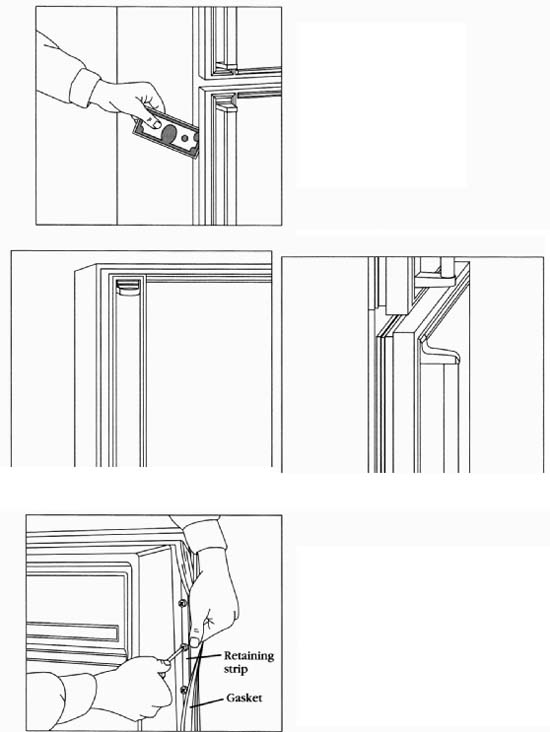
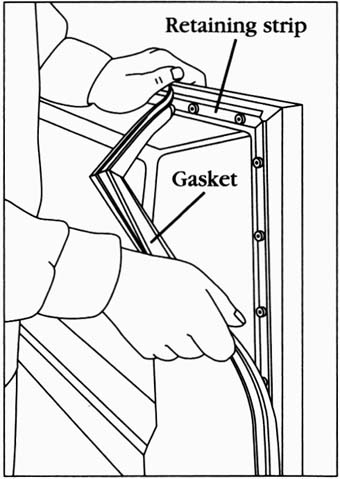
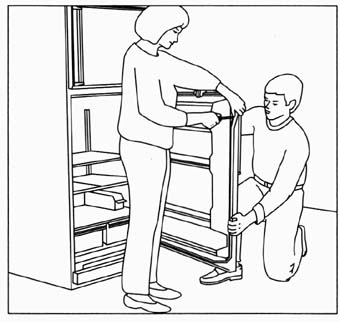
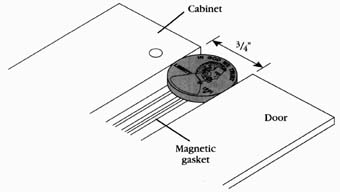
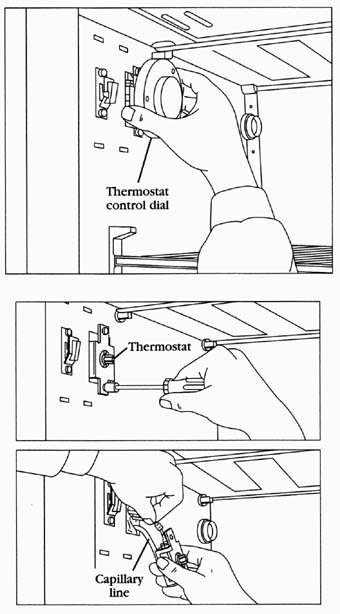
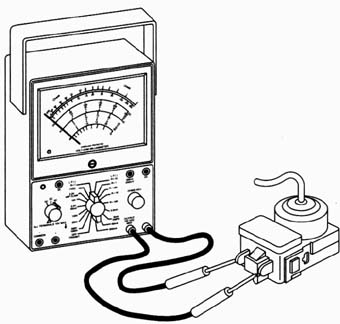
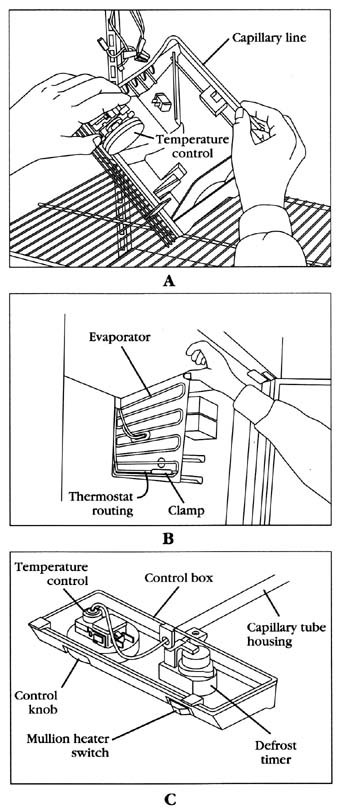
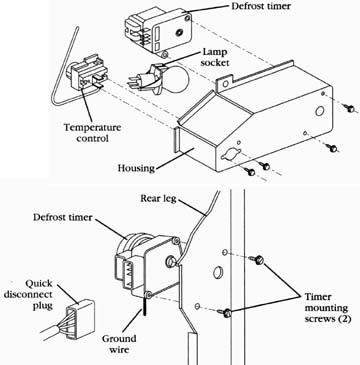
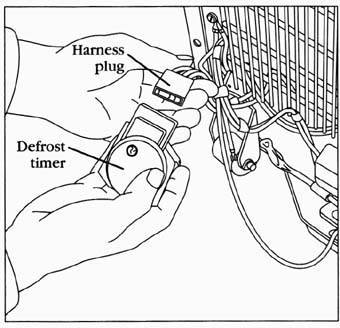
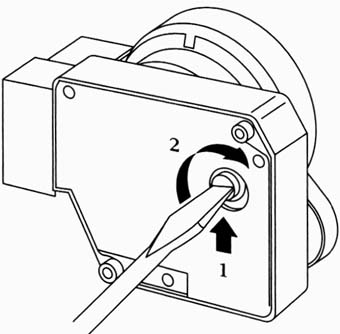
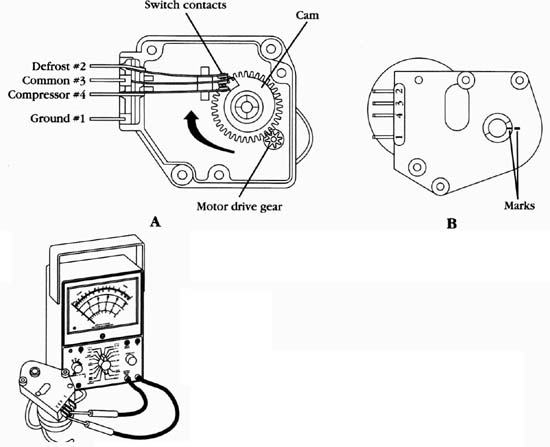
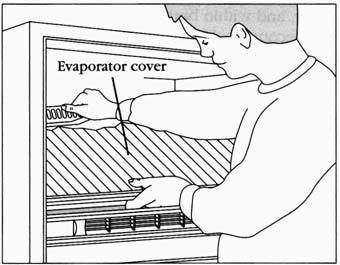
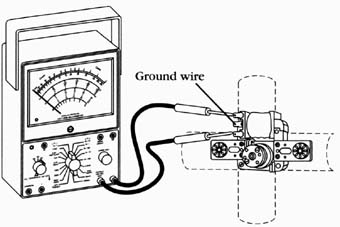
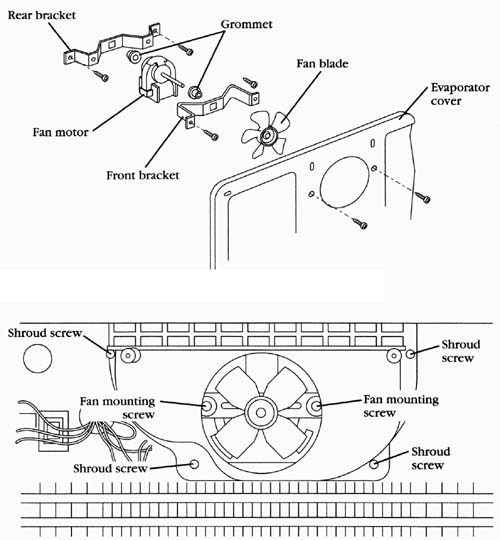
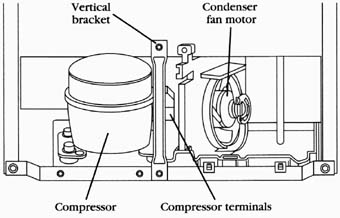
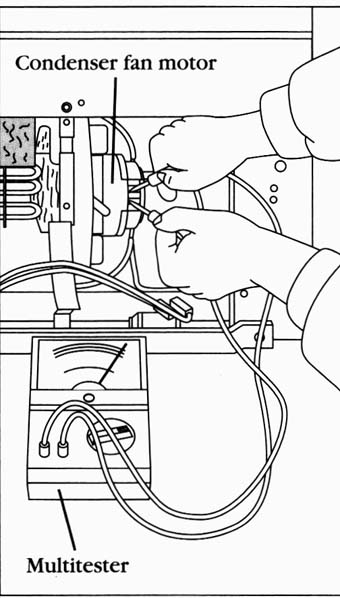
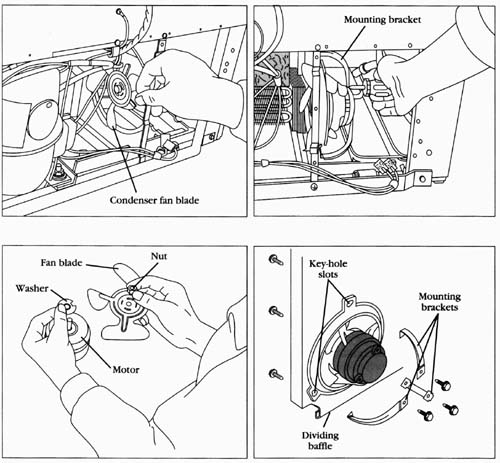
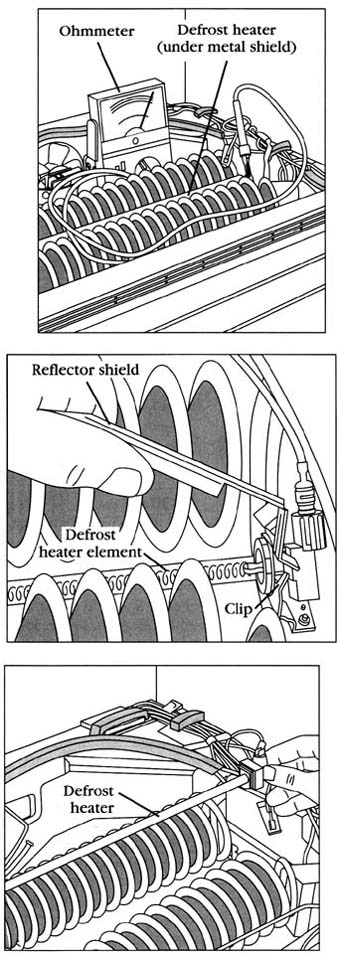
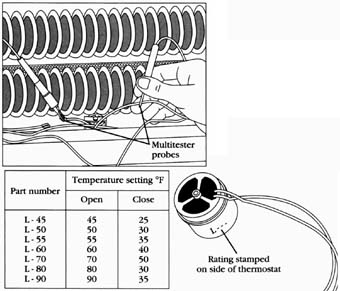 __30
Test the defrost thermostat when ft is connected to the evaporator coil.
Part number; Temperature setting °F -- Open; Close. __31 The temperature
rating chart for most common defrost thermostats. Rating stamped
__30
Test the defrost thermostat when ft is connected to the evaporator coil.
Part number; Temperature setting °F -- Open; Close. __31 The temperature
rating chart for most common defrost thermostats. Rating stamped 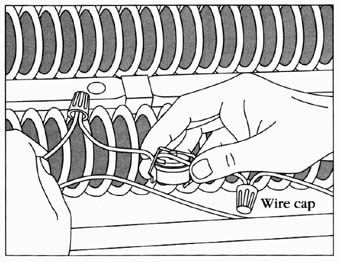
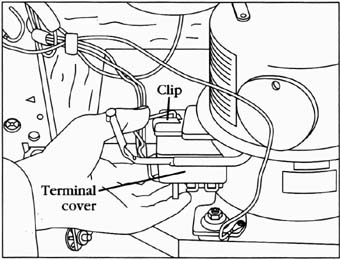
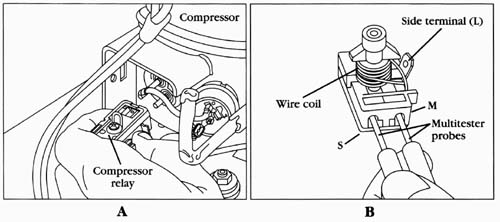

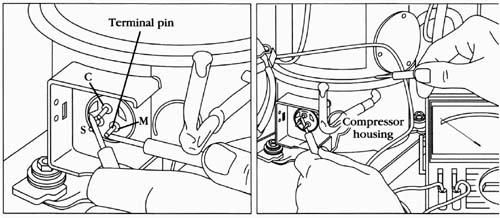
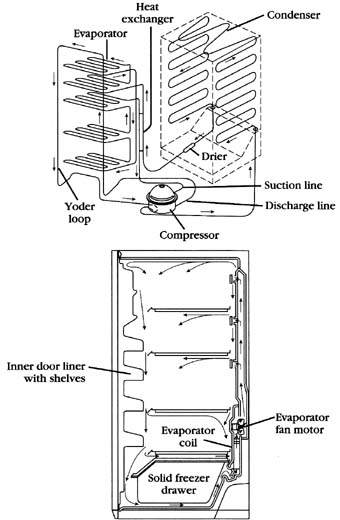
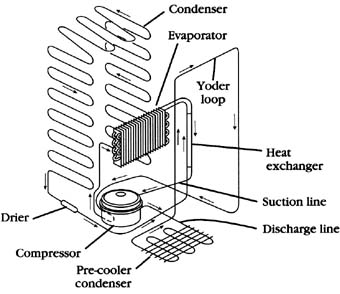
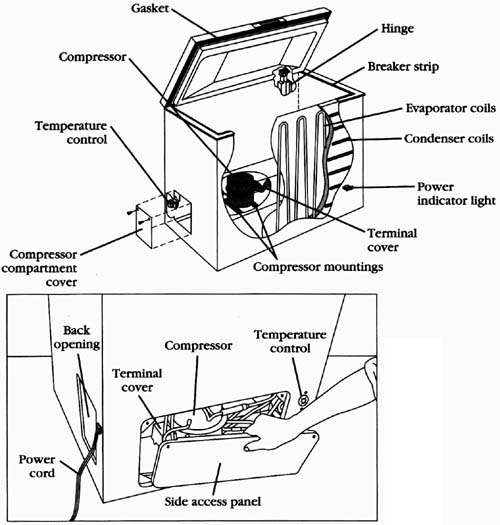
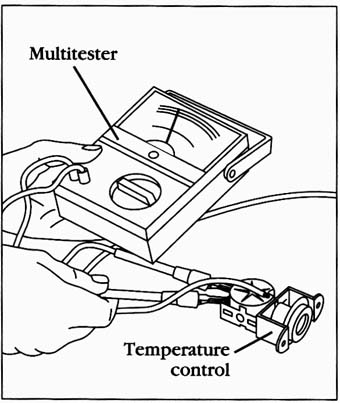 If you do, the freezer won’t
work properly.
If you do, the freezer won’t
work properly. 